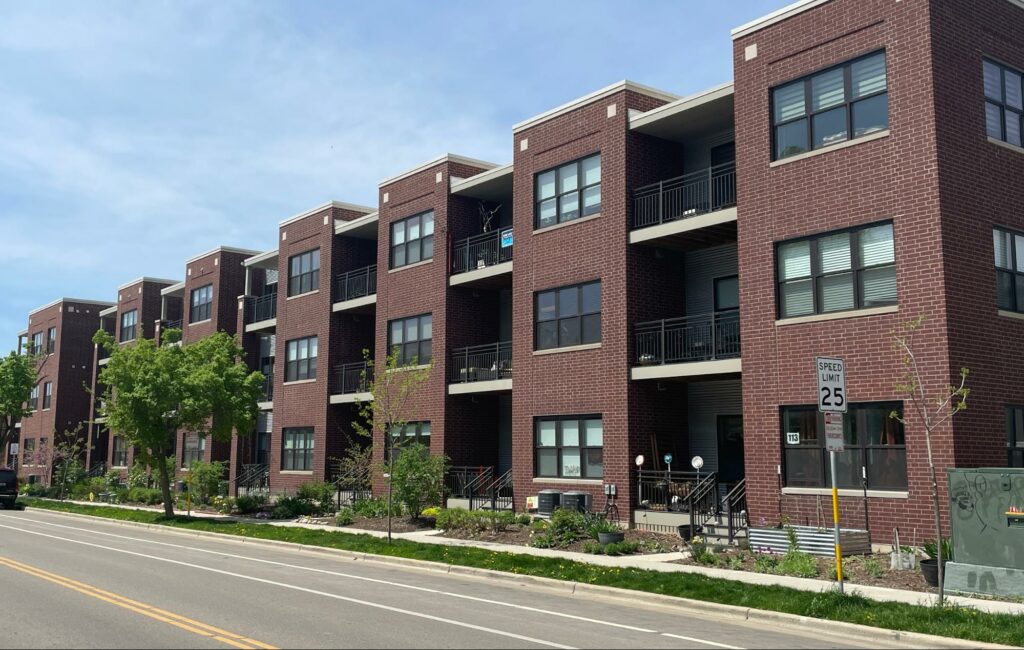
This story is part of a Madison Commons series produced by master's students in the School of Journalism and Mass Communication. These stories explore how people in Madison and Dane County find different ways to develop cultures within our community, looking look for opportunities to draw connections with each other to learn more about our world.
With the growing costs and challenges of housing in Madison, co-ops and cohousing communities offer a unique alternative
Cynthia Bachhauer appreciates the relationships she has with other residents in her building on Madison’s east side. Her family shares meals with neighbors once or twice a week, and her kids can often be found playing at a friend’s apartment or in the shared outdoor space. The children enjoy the close-knit community and so does she.
“It’s very good to know everybody I see when I walk around and to know that when you need something, someone’s there to help you,” Bachhauer said.
This kind of community did not happen by accident. For Bachhauer, her neighbors are not just people who live next to each other, but are members of Linden Cohousing, a multigenerational cooperative living community.

“Cohousing is a kind of planned community where each household owns their own household unit,” Bachhauer said. “In my case, we’re all in one building, so we own a full condo and then we share communal spaces, and we share taking care of those spaces and we also just kind of plan to live together.”
While cohousing provides separate residences for households, another variety of intentional community, co-ops, sees members living under a common roof. The Madison Area Cooperative Housing Alliance, a group that aims to increase awareness and education about cooperative housing, defines a co-op as “a residence that is collectively owned and controlled by its members.”
For each of these housing models, the common thread is to build an intentional community. Both co-ops and cohousing require a group of people who choose to live together in a lifestyle that reflects their shared values about building cooperative, democratic relationships. Often, the shared values extend beyond community building. For instance, in the over 30 co-ops in Madison, words including equity, sustainability, democracy, environment, inclusion and feminism appear in their mission statements.
Kyle Cushman, a former director of Madison Area Cooperative Housing Alliance, lives in Nottingham co-op in downtown Madison. By practicing cooperation and inclusion while educating others about their benefits, he believes cooperative living can help reshape the cultural landscape into a more equitable place. This begins with nonviolent models of communication.
“We’re very proactive when it comes to building relationships within the house,” Cushman said. “We operate entirely on consensus and don’t do majority vote here.”
He adds that putting structures in place to facilitate effective communication is critically important, especially when conflicts arise.
“We have monthly conflict resolution meetings where anyone can state a grievance,” Cushman said. “We have people trained in nonviolent communication to be mediators when there needs to be a third party.”
A similar model is used at Linden Cohousing.
“We have community business meetings twice a month, and we have a structure for how decisions are made,” Bachhauer said. “When there are interpersonal conflicts, we have a group setup that helps mediate conflicts, so we’ve got third parties to go to.”
She and Cushman both held the model of cooperative living up as something broader society should aspire to.
“What I’ve learned from living in a community is that you’re not going to be best friends with everybody,” Bachhauer said, “But we can live together, and we can take care of our place and take care of each other.”
Lacey Mehring, a member of Nottingham, said that being a part of a built-in community of diverse people contributes to a sense of feeling well-connected.
“You could message your friend and be like: “Hey, do you want to come over to paint our nails?” But maybe they live 20 minutes away,” Mehring said. “What about just going down one flight of stairs? Or down the hallway? I feel like it’s so much more accessible for people to build those relations because it’s not, you know, impeded by distance.”
The benefits of intentional communities extend beyond connecting to other people with shared values. Room rates in a co-op are usually less than half the cost of a one-bedroom apartment. In this way, co-ops provide a strong alternative to other housing options in Madison, where the mayor’s office estimates that half of all renters can’t afford their rent.
Many co-ops also offer a food share option to help cut costs of meal preparation. At Nottingham, residents contribute $60 a month to a food share and take turns cooking house meals.
“So, you’re looking at about an average of about $400 a month per person all together,” Cushman said.
While the benefits of living in a single household are substantial, cooperative living in individual households can have less of a financial benefit.
At Linden Cohousing, which is set up as a condo community, each individual household can expect to pay a mortgage that’s in keeping with the city’s median apartment rental costs, which is around $1400, according to a Capital Times analysis of Zillow’s data. Members at Linden also reserve several discounted units for low-income households. Common meals are offered several times a week.
For Bachhauer, the benefits of community living far outweigh any additional effort or time commitment.
“I don’t want to paint it as a utopia because it’s not a perfect place,” Bachhauer said. “But it is a very good place.”




